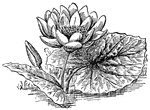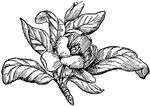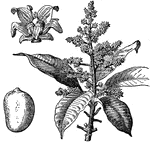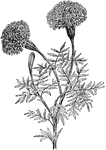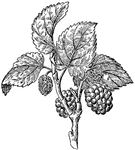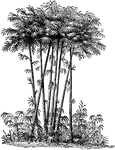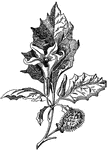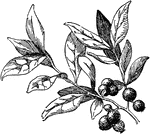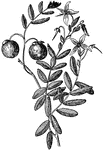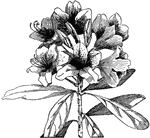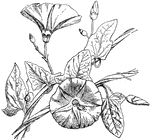
Pumpkin
"A climbing plant and its fruit, of the genus Cucurbita. The pumpkin is originally from India, but is…
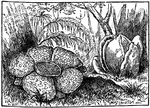
Raffle'sia Flower
This gigantic flower, one of the marvels of the vegetable world, was discovered in the interior Sumatra…

Illustration of Roots and Jericho Rose
A small cruciferous plant, growing in arid Arabia and Palestine. When full grown and ripe its leaves…

Rue Plant
A strong-scented herbaceous plant of the genus Ruta, nat. order Rutacae, a native of S. Europe, but…

Saw Fly Hovering Above a Plant
A group of insects belonging to the order Hymenoptera, and distinguished by the peculiar confirmation…

Opium Plant
The opium plant can be used to produce sleep, numb pain, and quiet the organs of the body.
Flower Parts
"Diagram to show the essential parts of a "flowering" plant. t.r., tap-root; cot. seed-leaf (cotyledon);…
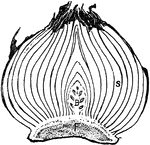
Tulip Bulb
"Tulip bulb; longitudinal section. F, solid stem; B, flower bud; S, leaf-bases serving as bud-scales,…

Sedum Leaf
"Leaf of a live-forever (Sedum sp.), with a portion of the epidermis peeled back. Underneath the epidermis…

Mullein Leaf
"Mullein (Verbascum Thapsus). L, cross-section of leaf-blade, showing relative thickness of a layer…

Leaf Epidermis
"Lizard's tail (Saururus cernuus). Portions of leaf-epidermis; U, upper epidermis; L, lower epidermis;…
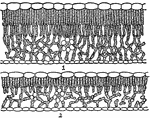
Oak Leaf Cross-Section
"Cross-sections of leaves of an oak (Quercus novimexicana), showing the effect of different light conditions…
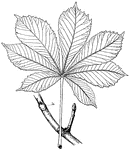
Horse-Chestnut Leaf
"Horse-chestnut (Aesculus Hippocastanum). ls, leaf-scar, showing scars of seven fibro-vascular bundles,…

Water Hyacinth Roots
"Roots of the water-hyacinth (Eichornia crassipes Solms), showing removable root-caps; b, root-cap removed…

Roots in Soil
"Diagram to illustrate a root-hair (h) in the soil, and its relation to the soil-particles, the capillary…
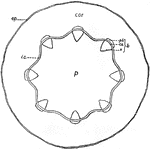
Castor-Oil Plant Stem
"Diagram showing tissue-systems in young stem of castor-oil plant (Ricinus communis), as seen in cross-section.…

Castor-Oil Plant Stem
"The castor-oil plant (Ricinus communis). Portion of cross-section of young stem. co, Cortex; p, pith…

Pellionia Plant Cell
"Cell of Pellionia Daveauana, showing starch-grains. The black, crescent-shaped body on the end of each…
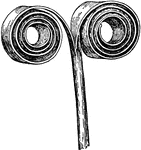
Dandelion Scape
"Portion of dandelion scape, showing "curls" resulting from longitudinal tissue-tension." -Gager, 1916

Knight's Experiment
"Knight's experiment, substituting centrifugal "force" for gravity" proved that stems do not grow upwards…

Leaflet Removal
"Effect of removal of a leaflet from a palmately compound leaf (e.g. Woodbine). B, normal leaf; C, after…

Fern Epidermis
"A, Upper epidermis; B, lower epidermis, of the fern, Drynaria meyeniana." -Gager, 1916

Fern Germination
"Germination of the spores of a fern. a, Before germination; b, early stage, showing protonema (pr.),…
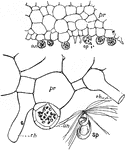
Fern Prothallus
"Fern prothallus; cross-sections showing antheridia (an), sperms (sp), and rhizoids (rh). Below at the…
Southern Adderstongue
"Adder's tongue fern (Ophioglossum vulgatum L.). R, runner or stolon." -Gager, 1916

Vegetable Cell
A, A young vegetable cell, showing cell cavity entirely filled with granular protoplasm enclosing a…

Hair-Cap Moss
"Hair-cap moss (Polytrichum commune). A, male plant; B, same, proliferating; C, female plant, bearing…
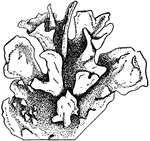
Anthoceros fusiformis
"Anthoceros fusiformis. Portion of lamellate, cristate thallus, which easily retains water." -Gager,…

Leafy Liverwort
"A leafy liverwort (Porella navicularis). Male plant, about natural size." -Gager, 1916

Bread Mold
"Bread mold (Rhizopus nigricans). A, older plant; myc, mycelia; sph, sporangiophore; sp, sporangium;…

Parasitic Plant
"Cissus laciniata, parasitic on the cactus (Opuntia Blakeana). The parasitism was artificially induced…
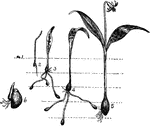
Dog's-Tooth Violet Stages
"Dog's-tooth violet (Erythronium americanum). Stages of development from the seed. 1-5 show the stage…

Monocotyledonous Morphology
"Morphology of typical monocotyledonous plant. A, leaf, parallel-veined; B, portion of stem, showing…

Dicotyledonous Morphology
"Morphology of a typical dicotyledonous plant. A, leaf, pinnately-netted veined; B, portion of stem,…
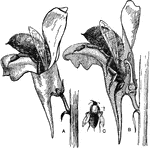
Common Toadflax with Insect
"Toad-flax (Linaria vulgaris). Flowers being visited by an insect for nectar. B, longitudinal section,…
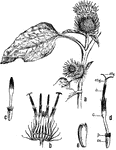
Lesser Burdock
"Inflorescence and flowers of the burdock (Arctium minus). a, Inflorescences; b, longitudinal section…

